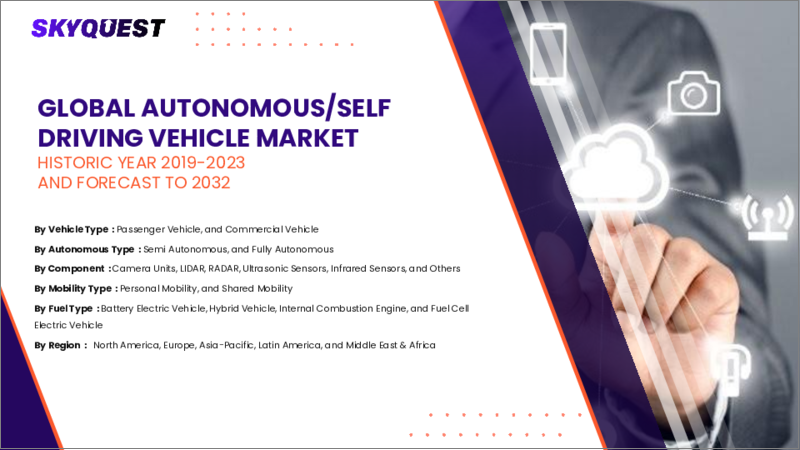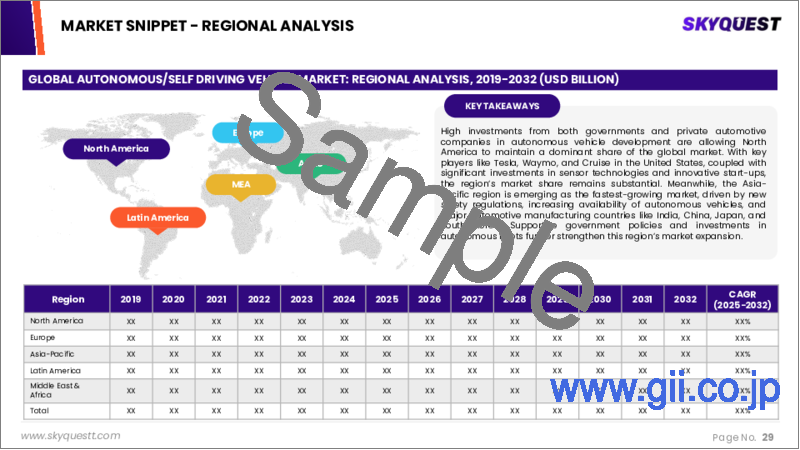|
|
市場調査レポート
商品コード
1569453
自律走行車(自動運転車)の市場規模、シェア、成長分析:自律走行タイプ別、コンポーネント別、車両タイプ別、モビリティタイプ別、燃料タイプ別、スタックレベル別、用途別、地域別 - 産業予測、2024-2031年Autonomous/Self Driving Vehicle Market Size, Share, Growth Analysis, By Autonomous Type, Component, Vehicle Type, Mobility Type, Fuel Type, Stack Level, Application, and Region - Industry Forecast 2024-2031 |
||||||
|
|||||||
| 自律走行車(自動運転車)の市場規模、シェア、成長分析:自律走行タイプ別、コンポーネント別、車両タイプ別、モビリティタイプ別、燃料タイプ別、スタックレベル別、用途別、地域別 - 産業予測、2024-2031年 |
|
出版日: 2024年10月10日
発行: SkyQuest
ページ情報: 英文 157 Pages
納期: 3~5営業日
|
- 全表示
- 概要
- 目次
自律走行車(自動運転車)の世界市場規模は、2022年に378億米ドルと評価され、2023年の520億9,000万米ドルから2031年には6,772億3,000万米ドルに達し、予測期間中(2024-2031年)のCAGRで37.8%の成長が予測されています。
高度なセンサーと人工知能を搭載した自律走行車または自動運転車は、人間のドライバーの必要性を排除するため、自動車の状況を一変させつつあります。これらの自動車の世界市場は、革新的な自律走行技術への多額の投資と、消費者の間での受け入れの拡大により、大幅に拡大するとみられます。自動車セクターにおけるデジタル技術統合の急増は、自動車の安全性重視の高まりと相まって、世界の自動運転車の販売をさらに後押ししています。このような有望な成長軌道にもかかわらず、開発に伴う高コストや市場の進展の妨げとなりかねない規制の不確実性など、課題も残されています。それにもかかわらず、米国の自律走行車市場は、今後予測される期間において堅調なCAGRを記録すると予想されており、この革命的な自動車分野に対する持続的な関心と進歩が示されています。業界がこのような課題を乗り越えていく中で、長期的な見通しは楽観的であり、継続的な技術革新によって車両運用の安全性と効率性の両方が向上し、それによって消費者の信頼が強化され、普及率が促進されるものと思われます。
目次
イントロダクション
- 調査の目的
- 定義
- 市場範囲
調査手法
- 情報調達
- 二次データソースと一次データソース
- 市場規模予測
- 市場の想定と制限
エグゼクティブサマリー
- 市場概要見通し
- 供給需要動向分析
- セグメント別機会分析
市場力学と見通し
- 市場力学
- 促進要因
- 機会
- 抑制要因
- 課題
- ポーターの分析
主な市場の考察
- 技術分析
- バリューチェーン分析
- 規制情勢
- 貿易分析
- ケーススタディ分析
- 特許分析
- PESTEL分析
- 価格分析
- サプライチェーン分析
- 重要成功要因
- 市場の魅力指数
- 競合の程度
- 主な投資機会
- エコシステムマッピング
自律走行車市場:自律走行タイプ別
- 市場概要
- 半自律
- レベル1
- レベル2
- レベル3
- 完全自律
- レベル4
- レベル5
自律走行車市場:コンポーネント別
- 市場概要
- カメラユニット
- LiDAR
- レーダー
- 超音波センサー
- 赤外線センサー
- その他
自律走行車市場:モビリティタイプ別
- 市場概要
- パーソナルモビリティ
- シェアードモビリティ
自律走行車市場:燃料タイプ別
- 市場概要
- BEV
- ハイブリッド車
- ICE
- FCEV
自律走行車市場:車両タイプ別
- 市場概要
- 乗用車
- ハッチバック
- クーペ・スポーツカー
- セダン
- SUV
- その他
- 商用車
- バス
- トラック
- その他
自律走行車市場:スタックレベル別
- 市場概要
- センサー技術
- 車両コンピューティングプラットフォーム
- 認識エンジン
自律走行車市場:用途別
- 市場概要
- ロボタクシー
- 個人用
- 軍事・防衛
- その他
自律走行車市場規模:地域別
- 市場概要
- 北米
- 米国
- カナダ
- 欧州
- ドイツ
- スペイン
- フランス
- 英国
- イタリア
- その他欧州地域
- アジア太平洋地域
- 中国
- インド
- 日本
- 韓国
- その他アジア太平洋地域
- ラテンアメリカ
- ブラジル
- その他ラテンアメリカ地域
- 中東・アフリカ(MEA)
- GCC諸国
- 南アフリカ
- その他中東・アフリカ地域
競合情勢
- 上位5社の比較
- 主要企業の市場ポジショニング(2023年)
- 主な市場企業が採用した戦略
- 市場における最近の活動
- 主要企業の市場シェア(2023年)
主要企業プロファイル
- Tesla(USA)
- Cruise(USA)
- Nuro(USA)
- Zoox(USA)
- Aurora Innovation(USA)
- Honda(Japan)
- Toyota(Japan)
- Hyundai(South Korea)
- Volkswagen Group(Germany)
- BMW(Germany)
- Mercedes-Benz(Germany)
- Nissan(Japan)
Global Autonomous/Self-driving Vehicle Market size was valued at USD 37.8 Billion in 2022 and is poised to grow from USD 52.09 Billion in 2023 to USD 677.23 Billion by 2031, at a CAGR of 37.8% during the forecast period (2024-2031).
Autonomous or self-driving vehicles, equipped with advanced sensors and artificial intelligence, are transforming the automotive landscape as they eliminate the need for human drivers. The global market for these vehicles is set to expand significantly, driven by substantial investments in innovative autonomous driving technologies and an increasing acceptance among consumers. The surge in digital technology integration within the automotive sector, coupled with a rising emphasis on vehicle safety, is further propelling the sales of self-driving cars worldwide. Despite this promising growth trajectory, challenges remain, including the high costs associated with development and the prevailing regulatory uncertainties that may hinder market progress. Nonetheless, the U.S. market for autonomous vehicles is anticipated to witness a robust compound annual growth rate (CAGR) in the coming forecast period, indicating a sustained interest and advancement in this revolutionary automotive segment. As the industry navigates these challenges, the long-term outlook remains optimistic, with continued innovations likely to enhance both safety and efficiency in vehicle operations, thereby reinforcing consumer trust and driving adoption rates.
Top-down and bottom-up approaches were used to estimate and validate the size of the global autonomous/self-driving vehicle market and to estimate the size of various other dependent submarkets. The research methodology used to estimate the market size includes the following details: The key players in the market were identified through secondary research, and their market shares in the respective regions were determined through primary and secondary research. This entire procedure includes the study of the annual and financial reports of the top market players and extensive interviews for key insights from industry leaders such as CEOs, VPs, directors, and marketing executives. All percentage shares split, and breakdowns were determined using secondary sources and verified through Primary sources. All possible parameters that affect the markets covered in this research study have been accounted for, viewed in extensive detail, verified through primary research, and analyzed to get the final quantitative and qualitative data.
global autonomous/self-driving vehicle Market Segmental Analysis
The global autonomous/self-driving vehicle market is segmented by autonomous type, component, mobility type, vehicle type, application, and region. Based on autonomous type, the market is segmented into Semi-autonomous (Level 1, Level 2, Level 3), and Fully Autonomous (Level 4, Level 5). Based on Components, the market is segmented into LiDAR, RADAR, Ultrasonic Sensors, Infrared Sensors, and Others. Based on Mobility Type, the market is segmented into personal mobility, and shared mobility. Based on Vehicle Type, the market is segmented into Passenger Vehicles and Commercial Vehicles. Based on Stack Level, the market is segmented into Sensor Technology, Vehicle Computing Platform, and Perception Engine. Based on Application, the market is segmented into robotaxi, individual use, military & defense and others. Based on region, the market is segmented into North America, Europe, Asia-Pacific, Middle East and Africa, and Latin America.
Driver of the global autonomous/self-driving vehicle Market
Rapid urbanization and escalating traffic congestion globally are pivotal market drivers for the autonomous/self-driving vehicle industry. As cities expand and populations increase, the necessity for efficient mobility solutions becomes paramount, leading to heightened interest in technologies that can alleviate traffic woes. Investments in innovative transportation systems further reinforce this demand, stimulating advancements in autonomous vehicle technologies. These vehicles promise not only to enhance the efficiency of urban commuting but also to reduce accidents and improve air quality. As stakeholders recognize the need for sustainable and convenient travel, the momentum for autonomous vehicles is set to grow, transforming urban landscapes and reshaping transportation paradigms.
Restraints in the global autonomous/self-driving vehicle Market
One significant market restraint for the global autonomous/self-driving vehicle market is the high cost of technology and components involved in their development. The complexity of sensor systems, software algorithms, and advanced robotics contributes to steep manufacturing expenses, leading to higher retail prices for end consumers. This financial barrier limits affordability and, consequently, broader adoption rates among potential users. As consumers weigh the benefits against the costs, many opt for traditional vehicles, slowing the transition to autonomous driving solutions. Consequently, this pricing challenge hinders market growth and the widespread acceptance of self-driving vehicles in the automotive industry.
Market Trends of the global autonomous/self-driving vehicle Market
The global autonomous/self-driving vehicle market is witnessing a significant trend fueled by the integration of 5G technology, which is anticipated to revolutionize vehicle communication and operational efficiency. With enhanced data transfer speeds and reduced latency, 5G enables vehicles to communicate seamlessly with one another and with central traffic management systems, thereby improving safety protocols and traffic flow. This technological advancement is paving the way for more reliable autonomous systems, fostering consumer trust, and accelerating widespread adoption. As a result, stakeholders in the automotive sector are increasingly investing in 5G-enabled solutions, driving innovation and shaping the future of transportation.
Table of Contents
Introduction
- Objectives of the Study
- Definitions
- Market Scope
Research Methodology
- Information Procurement
- Secondary & Primary Data Sources
- Market Size Estimation
- Market Assumptions & Limitations
Executive Summary
- Market Overview Outlook
- Supply Demand Trend Analysis
- Segmental Opportunity Analysis
Market Dynamics & Outlook
- Market Dynamics
- Drivers
- Opportunities
- Restraints
- Challenges
- Porters Analysis
- Competitive rivalry
- Threat of Substitute Products
- Bargaining Power of Buyers
- Threat of New Entrants
- Bargaining Power of Suppliers
Key Market Insights
- Technology Analysis
- Value Chain Analysis
- Regulatory Landscape
- Trade Analysis
- Case Study Analysis
- Sensor Package For Self-driving Cars And Reliability Test By Konrad Technologies
- [if !supportLists] [endif] Nvidia Provides An Open Autonomous Vehicle Development Platform, An End-to-end Solution For Self-driving Vehicles
- [if !supportLists] [endif] Zf Releases New Ai-based Services For Advanced Driver Assistance Systems Development
- Patent Analysis
- Pestel Analysis
- Pricing Analysis
- Supply Chain Analysis
- Key Success Factors
- Market Attractiveness Index
- Degree of Competition
- Top Investment Pockets
- Ecosystem Mapping
Autonomous Vehicle Market by Autonomous Type
- Market Overview
- Semi-autonomous
- Level 1
- Level 2
- Level 3
- Fully Autonomous
- Level 4
- Level 5
Autonomous Vehicle Market by Component
- Market Overview
- Camera Units
- LIDAR
- RADAR
- Ultrasonic Sensors
- Infrared Sensors
- Others
Autonomous Vehicle Market by Mobility Type
- [if !supportLists] [endif] Market Overview
- Personal Mobility
- Shared Mobility
Autonomous Vehicle Market by Fuel Type
- Market Overview
- Battery Electric Vehicle
- Hybrid Vehicle
- Internal Combustion Engine
- Fuel Cell Electric Vehicle
Autonomous Vehicle Market by Vehicle Type
- Market Overview
- Passenger Vehicle
- Hatchbacks
- Coupe & Sports Cars
- Sedan
- SUV
- Others
- Commercial Vehicle
- Bus
- Trucks
- Others
Autonomous Vehicle Market by Stack Level
- Market Overview
- Sensor Technology
- Vehicle Computing Platform
- Perception Engine
Autonomous Vehicle Market by Application
- Market Overview
- Robotaxi
- Individual Use
- Military & Defense
- Others
Autonomous Vehicle Market Size by Region
- Market Overview
- North America
- USA
- Canada
- Europe
- Germany
- Spain
- France
- UK
- Italy
- Rest of Europe
- Asia Pacific
- China
- India
- Japan
- South Korea
- Rest of Asia-Pacific
- Latin America
- Brazil
- Rest of Latin America
- Middle East & Africa (MEA)
- GCC Countries
- South Africa
- Rest of MEA
Competitive Landscape
- Top 5 Player Comparison
- Market Positioning of Key Players, 2023
- Strategies Adopted by Key Market Players
- Recent Activities in the Market
- Key Companies Market Share (%), 2023
Key Company Profiles
- Tesla (USA)
- Company Overview
- Business Segment Overview
- Financial Updates
- Key Developments
- Cruise (USA)
- Company Overview
- Business Segment Overview
- Financial Updates
- Key Developments
- Nuro (USA)
- Company Overview
- Business Segment Overview
- Financial Updates
- Key Developments
- Zoox (USA)
- Company Overview
- Business Segment Overview
- Financial Updates
- Key Developments
- Aurora Innovation (USA)
- Company Overview
- Business Segment Overview
- Financial Updates
- Key Developments
- Honda (Japan)
- Company Overview
- Business Segment Overview
- Financial Updates
- Key Developments
- Toyota (Japan)
- Company Overview
- Business Segment Overview
- Financial Updates
- Key Developments
- Hyundai (South Korea)
- Company Overview
- Business Segment Overview
- Financial Updates
- Key Developments
- Volkswagen Group (Germany)
- Company Overview
- Business Segment Overview
- Financial Updates
- Key Developments
- BMW (Germany)
- Company Overview
- Business Segment Overview
- Financial Updates
- Key Developments
- Mercedes-Benz (Germany)
- Company Overview
- Business Segment Overview
- Financial Updates
- Key Developments
- Nissan (Japan)
- Company Overview
- Business Segment Overview
- Financial Updates
- Key Developments






